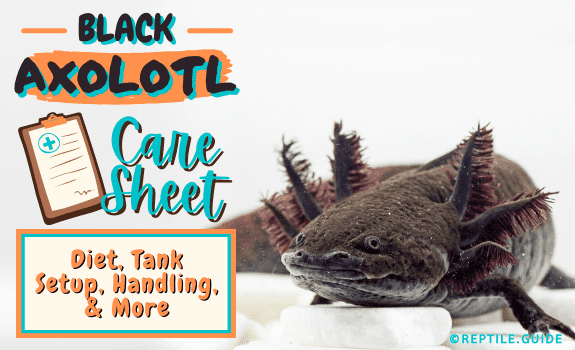Just as with the ball python, breeders have created various morphs; the black axolotl is one kind of morph.
This article covers the care needs of the black axolotl and the species in general.
In This Article
About the Black Axolotl
- Axolotls (Ambystoma mexicanum) are salamanders that never move beyond the larval stage.
The term for this retention of juvenile characteristics into adulthood is neotenic. - Axolotls are also known as Mexican walking fish.
They live their entire lives in water. Though they have lungs, they mostly rely on their external gills. - Axolotls are descendants of the tiger salamander who retain their larval form throughout their life.
- Mexican walking fish live only in Lake Xochimilco and some of the surrounding lakes of Mexico’s Xochimilco-Chalco basin.
- The IUCN classifies the wild population as endangered due to the destruction of habitat.
However, they’re widely bred in captivity for medical research and the pet trade. - Breeders have created various morphs; the black axolotl is one kind of morph.
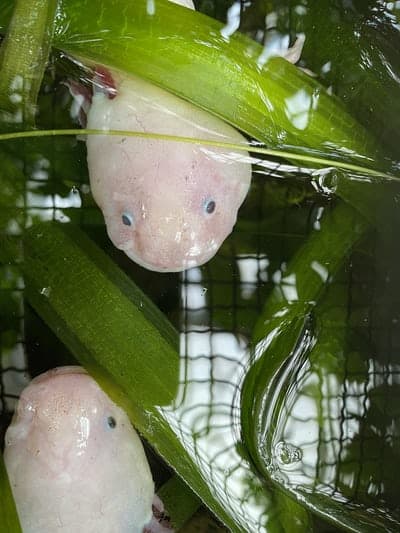
Do Black Axolotls Have Special Care Requirements?
Other than color, there is no difference between the black axolotl and any other members of the species.
All Mexican walking fish have the same care requirements.
If you have experience keeping a freshwater aquarium, then the black axolotls will make a great pet.
They’re hardy, engaging, and easy to care for if you can maintain the proper water quality. Axolotls can live for up to 15 years.
Know The Law!
Before you consider getting any axolotl, it’s important to know your state and local laws.
Some states and localities have laws that restrict or limit the sale of axolotls. Virginia, California, Maine, and New Jersey are examples of such states.
Other states, such as New Mexico, allow owning an axolotl, but you can’t import them from another state.
Do Black Axolotls Make Good Pets?
Axolotls make great pets if you know how to maintain a freshwater aquarium.
The biggest challenge for keeping axolotls is maintaining the proper water quality as you would with a freshwater tank.
If you keep up the water quality, everything else about the care of axolotls is simple. Plus, they make interesting and engaging pets.
How Long Do Black Axolotls Live?
With proper care, axolotls can live for up to 15 years in captivity.
Since they’re so rare in the wild, we have no record of their life expectancy outside captivity.
Black Axolotl Care
The care requirements of the black axolotl are the same as any other axolotl morph. These care requirements include:
Tank Size and Setup for Black Axolotls
For an adult black axolotl tank setup, we recommend that you get a 20-gallon aquarium.
While you could keep them in a smaller aquarium, maintaining the water quality is easier when you have a larger volume of water.
Axolotls frequently foul up their water.
Larger volumes of water will be more forgiving of the nitrogen level of the water.
Axolotls will eat anything that fits into their mouths, including other axolotls.
While we don’t recommend keeping more than one animal in the same tank, a larger aquarium will provide more room for them to avoid each other.
As axolotls never leave the water, they don’t need basking areas.
Lighting Requirements
Axolotls avoid direct light, so provide dim lighting instead.
Also, provide hides where your axolotl can take refuge when it wants a dark space. Axolotls will avoid UVB light as they’re sensitive to it.
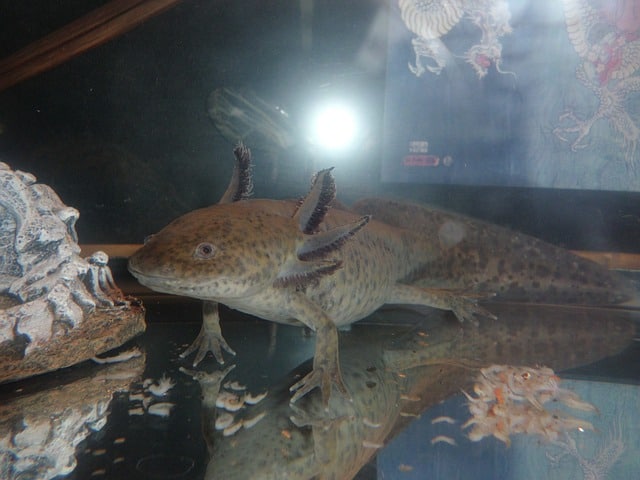
Tank Lid
While black axolotls are completely aquatic, they may jump out of tanks.
It’s important that you equip the axolotl tank with a tight-fitting lid.
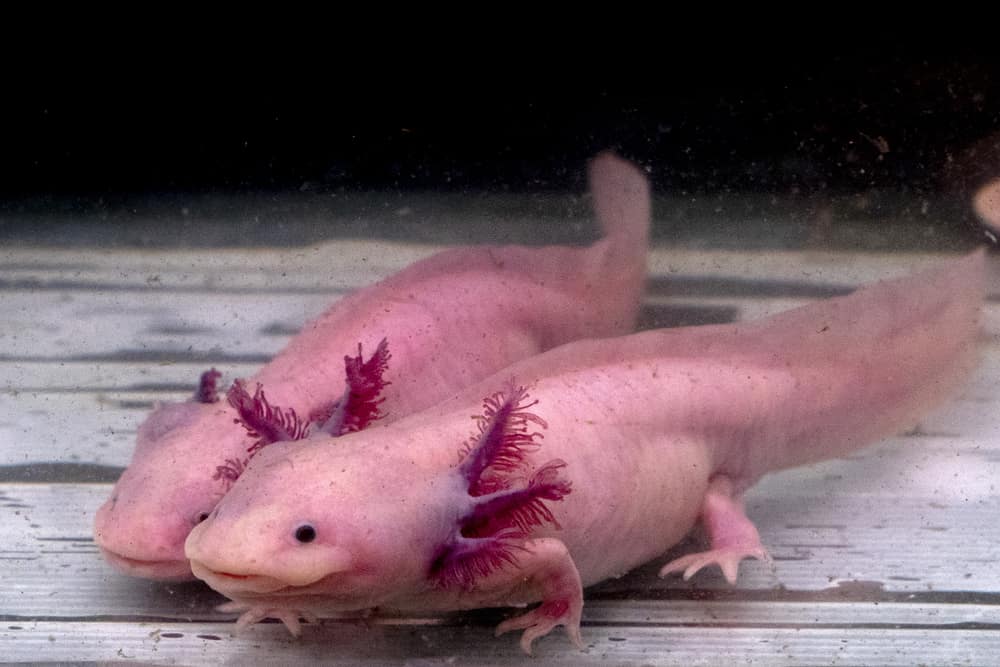
Plants
We don’t recommend live plants for use in your pet’s tank. Live plants need light to thrive, while the axolotl prefers dim light.
We recommend that you use plastic plants instead. Plastic plants provide an additional benefit in breaking up the water flow from the filter.
Pet axolotls can become stressed from the fast-moving water that comes from the filter output.
Using plastic plants to create a barrier around the outflow will reduce the speed of water flow.
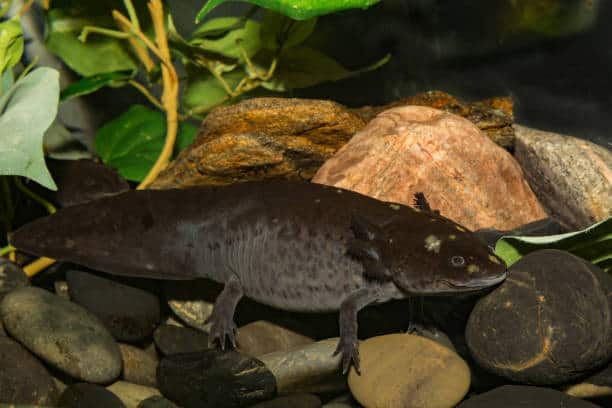
Water Quality and Temperature for Black Axolotls
The water quality needed by black axolotls is the same as for other kinds of axolotls. Managing water quality involves:
Filtration
Poor water quality is the most common cause of death in axolotls. The easiest way to maintain water quality is to use sponge filters as sold for aquariums.
As stated earlier, axolotls can become stressed from fast-moving water, so use plastic plants or other objects to create a barrier to slow down the water flow.
It’s a balancing act as you want to slow down the outflow from the filter without compromising the filter’s effectiveness to do its job.
Treating the Tank
As with tropical fish, you don’t want to use untreated tap water in the tank.
Tap water contains chlorine, chloramines, and other elements that can be harmful to your black axolotl.
You need to treat the water used in the tank so that it’s safe for your axolotl. As you would with tropical fish, add a water conditioner.
You can buy water conditioners from most pet stores. The water conditioner will remove any harmful elements from the water.
PH
PH refers to the amount of acidity in water. The pH for your pet’s water should be between 6.6 and 7.5. PH kits are available at your local pet store.
Temperature
In the wild, black axolotls inhabit the waters that come from mountain streams.
They’re a cold-water species. The water temperature should range from 60 and 64 degrees Fahrenheit (16-18 degrees C).
Expert Tip: Never let the water temperature go over 75 degrees, as this can be fatal.
Cycling the Tank
An aquarium is a habitat. This habitat, even before you add the axolotl, contains beneficial bacteria and various elements in the water.
It takes time for these bacteria to establish themselves and for the elements to stabilize. Let the tank cycle by allowing it to sit for two weeks before you introduce your pet to it.
As the tank cycles, continue to check the pH of the water.
Water Changes
As with a freshwater aquarium, there will be a nitrogen buildup. You can’t avoid it.
The nitrogen comes from the waste excreted from the animals that live in it. It also comes from uneaten food left in the tank.
To help reduce the buildup of nitrogen, you’ll need to do a water change. Doing a water change involves replacing 20% of the tank water.
Water changes involve siphoning water from the bottom of the tank.
Replace the old water with fresh water of the same temperature as the old water and treat using a water conditioner.
If you don’t have a filter, you should do water changes daily. If you do have a filter, do a weekly water change. Water changes help prevent the buildup of nitrates in the water.
Feeding Black Axolotls
In the wild, axolotls were the top predator in their aquatic habitat till the introduction of exotic fish species.
In their natural environment, axolotls prey on worms, insect larvae, crustaceans, mollusks, and small fish.
In captivity, you can feed axolotls:
- Small steps of liver or beef
- Brine shrimp
- Earthworms
- Bloodworms
- Tubifex Worms
- Frozen fish food
- Frozen pellets
- Commercial fish pellets
Don’t feed wild caught food as they may have parasites.
You can present food to your pet by using round nose forceps to dangle the food in front of your pet.
You can also drop the food in front of them; frozen food and pellet food are especially good for this.
With axolotls, no vitamins or mineral supplements are necessary.
Be alert to any uneaten food in the tank. You should remove it the same day to avoid polluting the water.
You can feed adult axolotls every other day, and young individuals daily. Axolotls will stop feeding when they’re full.
Feel free to check out our axolotl diet guide to learn more.
Should You Keep Axolotls in Pairs?
As previously mentioned, it’s best to keep axolotls alone. Young axolotls have cannibalistic tendencies.
Though adult axolotls are less inclined to feed on their own kind, they may eat tank mates that are smaller than them.
As for tropical fish, they may pick at the axolotl’s gills if they don’t become a meal for it first.
It’s best not to keep other creatures with your axolotl unless they’re axolotls of equal size.
Health Concerns
Although axolotls are hardy pets, they can experience health issues :
- Hyperthermia: As a cold-water species, the ideal water temperature for axolotls is between 60 and 64 degrees.
They can experience health problems when you keep temperatures higher than this. At higher temperatures, axolotls may also stop eating.
They also may become too buoyant. Other health issues caused by higher temperatures include bacterial infections. - Obstructions: Because of their voracious appetite, axolotls may ingest foreign objects that can cause obstructions in their digestive tract.
Obstructions can be fatal. The most important thing you can do to avoid this is to be careful of the substrate you use.
If you use substrate, choose one that’s too big for your pet to swallow.
Symptoms of obstructions include sluggishness and a loss of appetite. - Overfeeding: Avoid having your pet from becoming obese by not overfeeding your axolotl (See the section on Feeding).
- Exophthalmia: Exophthalmia is a condition caused by bad water quality. It’s the result of long-term exposure to elevated nitrate levels.
Exophthalmia presents as bulging eyes. A good filtering system, along with regular water changes, will help prevent this condition from occurring. - Skin infections: Also caused by improper water conditions, skin infections can be bacterial or fungal in nature.
- Ammonia buildup: Ammonia is a product of your pet’s waste and uneaten food. Ammonia buildup can lead to:
- Inflammation
- Viral or bacterial infections
- Respiratory problems and gill damage
- “Gulping,” which is when the axolotl seems to be gulping for air
- Injuries from sharp objects: As axolotls lack protective scales and have delicate gills, they can easily injure themselves on sharp objects.
Make sure that your pet’s tank doesn’t have any sharp objects in it. - Air in the abdomen: This condition normally occurs in young animals and presents as the axolotl floating upside down.
This condition occurs when the immature digestive system of the axolotl acclimates to a high protein diet.
This condition will correct itself as the axolotl matures.You can help avoid this condition from occurring by reducing the portion size that you feed your pet.
If you ever have any doubts about your pet’s health, seek veterinary advice.
If you want an odd and engaging pet and know something about keeping a freshwater aquarium, the axolotl may be right for you.
We hope you’ve enjoyed this article about the black axolotl.
You may also like our albino axolotl care sheet or axolotl pet care guide for more answers to other axolotl FAQs.
If you like amphibians in general, then you might like our articles about species like the whites tree frog and the chubby frog.
We also talk about reptiles, like the veiled chameleon and the tokay gecko.
Are you planning on getting a black axolotl? Let us know in the comments.
